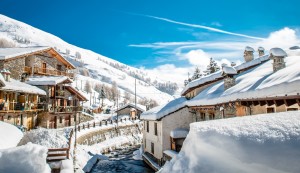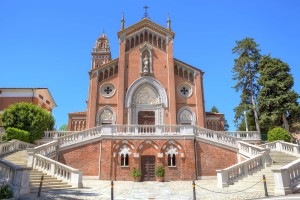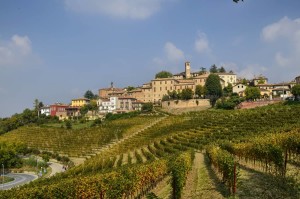Vast slopes and impressive nature turn the multifaceted, magical Province of Cuneo in the westernmost part of Piedmont into a spectacular place to be. Bordering France and Liguria, this area in the northwest of Italy is part of the Cottian Alps featuring many a tremendous mountain giant, such as the Passo Agnello (2,748 m). To the east, however, it leads into the Po Valley with the river Tanaro and its many. Putting aside its charming cities, such as Bra, Alba and the provincial capital Cuneo, there are five particularly beautiful places that belong to the private association “I borghi più belli d’Italia.” Read on to learn more about the many hidden treasures that await you here.

©Bigstock.com/alessandrogiamello
Chianale
To be a bit more precise, Chianale is actually a frazione of the municipality Pontechianale with approx. 170 inhabitants. It is located at the upper Valle Varaita running through the Cottian Alps over about 50 km with Maddalena, picturesquely situated at the reservoir lake Lago Pontechianale, as its principal town. You need to ascend to an altitude of about 1,800 m to reach Chianale. Plenty of rock and stone buildings await you here, such as the stone bridge across the river Varaita, which divides Chianale in two. The fairly plain church San Antonio dates back to the 14th century and enchants with its Romanesque portal. Another must-see is Casa Martinet, a former Calvinist temple. It highlights Chianale’s special position during the 16th century as the only place in the entire valley with freedom of religion.
Garessio
In sharp contrast to Chianale, there are over 2,900 inhabitants at an altitude of 621 m in Garessio. Still, this municipality is another one of the most beautiful places in Italy. It used to be an important stop for salt traders during the Middle Ages, became a major spa town around the early 20th century due to its mineral water sources, only to reinvent itself in recent years as a year-round destination for hikers, mountain bikers, and skiers.
Garessio is a delightful place if you’re looking to spend a sporty holiday in Piedmont. Its membership status with “I borghi più belli d’Italia,” however, mostly stems from the well-preserved medieval hamlet Borgo Maggiore. The many grand things to see here include the tower Ponte Rosa, which currently houses an art gallery, Casa Odda with its Gothic windows on a façade made of stone and brick, and the Bricco. These buildings below the castle hill might be a bit run-down, but they are certainly among Garessio’s most fascinating structure. Don’t sleep on Porta Jhape, the town gate that’s still connected to the medieval town walls. The old road of the salt traders runs past nearby.

©Bigstock.com/rglinsky
Monforte d’Alba
Wine aficionados might already be familiar with Monforte d’Alba. The grapes for the red wine Dolcetto d’Alba are grown in this place with nearly 2,000 inhabitants. But there are more wine credentials, like the Nebbiolo and Barbera grapes, or the sparkling wine Alta Langa. The vast winegrowing area was actually named UNESCO World Heritage Site in 2014 – the 50th Italian site to receive this honour.
Look forward to several opportunities to sample regional fine wines with many a vineyard tour plus wine tastings. Furthermore, Monforte d’Alba managed to retain its medieval layout that fans out toward the valley. Old sundials and oratories are just some of the rather peculiar sights awaiting you along the steep old roads. The belltower is the last surviving witness of the parish church that was first mentioned in 1223. However, nothing but ruins remained of the original castle (first documented in the 11th century) after it was attacked by Savoyard forces. It has since given way to Palazzo Scarampi.

©Bigstock.com/Massimo Parisi
Neive
Neive (around 3,300 inhabitants), too, is amidst the famous winegrowing region. The grapes are used for Dolcetto d’Alba, the sweet sparkling wine Asti Spumante and the still wine Moscato d’Asti. Excellent meat and pasta dishes, such as Tajarin al Tartufo (handmade pasta with truffles), and a delicious hazelnut cake spoil the palate.
Neive’s actual roots date back to Roman times. Its names derives from the noble Roman family Gens Naevia, the former owners. Still, you’ll mostly get to see medieval architecture here. Among the oldest buildings is the Romanesque 10th century Torre del Monastero, originally part of a Benedictine monastery. Check out the 13th century Torre dell’Orologio to see a Roman memorial plaque. And definitely don’t forget Casa Bongioanni – one of the newer buildings (constructed around 1750) with rich decorations and numerous frescos.
Ostana
Ostana almost became non-existent a couple of years ago. The village used to be home to almost 1,200 inhabitants in 1921, only to dip below 70 around 2006. Investments in tourism brought some relief – the number is getting close 90, even more during the summer months – but there’s still a long way to go. However, the village at the upper course of the Po river at an altitude of 1,200 m is very much worth seeing. The old structures of the medieval village centre very much bring Ostana’s origins to mind, accompanied by magical views of several tall mountains. Stop by the town hall La Villo, home to a museum, a spa, and – very soon – a climbing wall.
As different as the five most beautiful places in the Province of Cuneo in Piedmont may be, they all strive to preserve their medieval charm showing off spots that are timeless without being stuck in the past. Magnificent sights, many a fine wine in the UNECSO winegrowing regions, and excellent views of wide valley and astonishing mountain massifs line your next tour of the province. Time for a proper holiday!